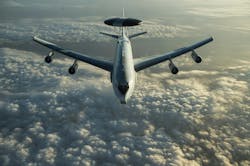Air Force picks Booz Allen to design upgraded communications for E-3 AWACS radar surveillance aircraft
HANSCOM AIR FORCE BASE, Mass. – U.S. Air Force airborne communications experts needed upgrade communications aboard the E-3 Sentry Airborne Warning and Control System (AWACS) aircraft. They found a solution from Booz Allen Hamilton Inc. in McLean, Va.
Officials of the Air Force Lifecycle Management Center at Hanscom Air Force Base, Mass., announced a $9.7 million contract to Booz Allen last week for the E-3 AWACS Communication Integration Program (ACIP).
Booz Allen will design and build the second-generation anti-jam tactical ultra-high frequency (UHF) radio system modification aboard the Air Force AWACS fleet.
Airborne radar
The AWACS airborne radar is mounted on modified versions of the Boeing 707 single-aisle passenger jet. The mobile long-range radar provides an airborne surveillance and air traffic control center for to warn of wide-area threats, and to help coordinate complex air attacks.
AWACS provides early warning, air battle management, and intelligence gathering. It has a distinctive large Frisbee-like rotating radar antenna mounted to the top of the plane's fuselage. The plane has been flying since 1977.
AWACS will be replaced by the Boeing E-7A airborne early warning and control (AEW&C) radar aircraft, which will resemble the Australian E-7A Wedgetail aircraft. The E-7A is based on the Boeing 737-700ER long-range single-aisle passenger jetliner, and will perform simultaneous air and sea search, as well as combat air traffic control.
The AWACS ACIP project focuses on upgrading AWACS communications capabilities. It will enhance the E-3 AWACS ability to communicate with other military systems with advanced communication systems and RF waveforms to improve interoperability among U.S. and NATO forces.
ACIP replaces older radios with newer units that can use the Mobile User Objective System (MUOS) and the Second Generation Anti-Jam Tactical UHF Radio for NATO (SATURN). The upgraded radios will communicate via existing and new military RF waveforms. ACIP provides more reliable and secure communication links for the E-3 AWACS for improved situational awareness.
On this contract, Booz Allen will do the work at Tinker Air Force Base, Okla., and should be finished by October 2028. For more information contact Booz Allen Hamilton online at www.boozallen.com, or the Air Force Lifecycle Management Center at www.aflcmc.af.mil.
About the Author
John Keller
Editor-in-Chief
John Keller is the Editor-in-Chief, Military & Aerospace Electronics Magazine--provides extensive coverage and analysis of enabling electronics and optoelectronic technologies in military, space and commercial aviation applications. John has been a member of the Military & Aerospace Electronics staff since 1989 and chief editor since 1995.
